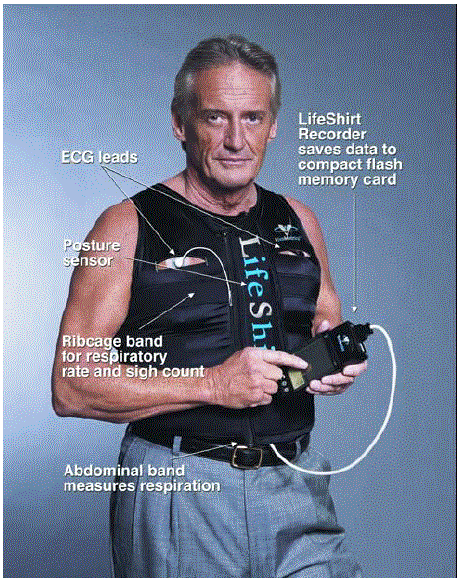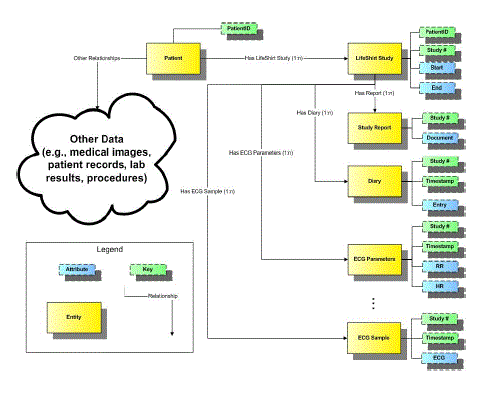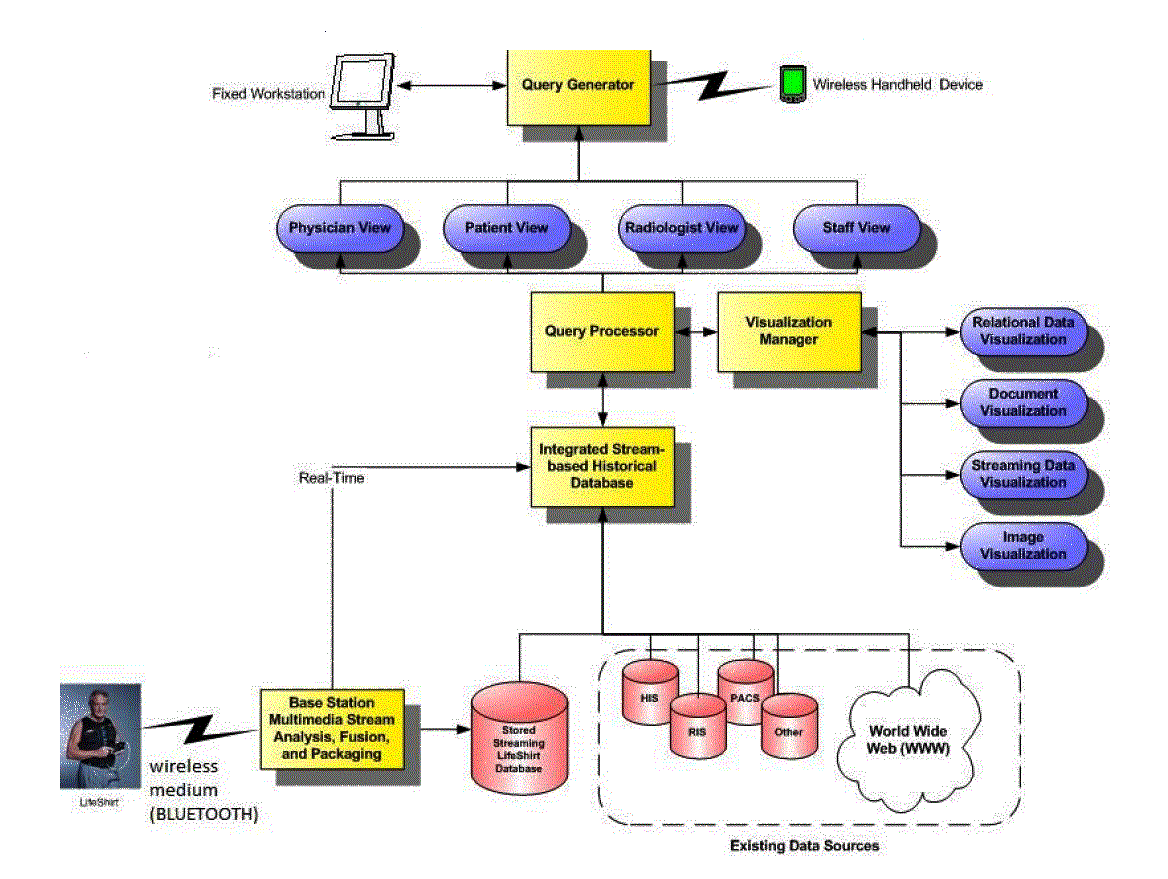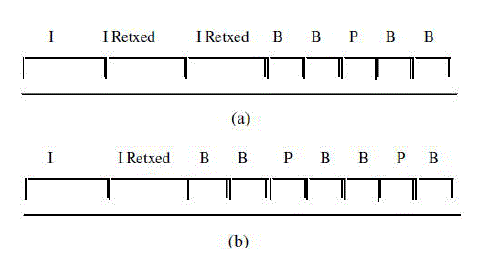Keywords
|
| Lifeshirt, Bluetooth, Streaming data |
INTRODUCTION
|
| Data retrieved from body sensors such as ECG machines and new-generation multi-sensor systems such as respiratory monitors are numerous and abundant. Managing and integrating this streaming data with existing types of medical information such as patient records, laboratory results, procedures, medical documents, and medical images in a logical and intuitive way is a challenge. Not only is the management of such data difficult but also is the visualization and presentation of the data to physicians, specialists, and even patients. Using the VivoMetrics LifeShirt as a testbed, we have proposed a data management system for dealing with such streaming body sensor data in addition to an extensible architecture that would allow for easy visualization of such data Section 2 highlights the VivoMetrics LifeShirt, its capabilities, the types of data generated, and thechallenges in managing such data. Section 3 presents a database schema for managing such streaming data and how it is integrated with the existing medical information. It also presents a streaming database architecture that will provide wireless transmission using Bluetooth as the medium (implementing the link layer scheme) for streaming medical and conventional data in real time. (e.g., medical images, laboratory results, medical documents). Section 4 presents future uses for the VivoMetrics LifeShirt in our research. |
| (EKG); as is shown in Figure 1. An on-board PDA (currently a Handspring Visor) continuously encrypts and stores the patient's physiologic data on a compact flash memory card. Posture and activity information is also tracked and recorded, and the PDA has an electronic patient diary to record subjective patient data about mood, symptoms and activity. The LifeShirt vest is easy to wear. Sensors are woven into the shirt around the patient's chest and abdomen. A two-axis accelerometer records patient posture and activity level. |
| VivoLogic, a proprietary PC-based software, decrypts and processes recorded data, and provides viewing and reporting features for researchers and clinicians to view the fulldisclosure, high-resolution waveforms (see Figure 2) or look at trends over time. Summary reports can be generated that present processed data in concise, graphical and numeric formats. |
SECTION
|
MULTISENSOR SYSTEMS, THE LIFESHIRT
|
| Description |
| The LifeShirt System is an example of an innovative ambulatory multisensor continuous monitoring system for collecting, analyzing and reporting health data, capturing an ongoing "movie" of physiologic data rather than episodic "snapshots" collected during periodic office visits. A method of respiratory monitoring called inductive plethysmography enables clinicians to capture a highly accurate view of patients? breathing. |
| The LifeShirt System is able to collect body data through various sensors, including respiratory bands, which measure pulmonary function (tidal volume, respiratory rate, etc; currently numbering about 24 parameters) as well as electrical activity of the heart |
Testbed usage
|
| The LifeShirt is used to generate significant amounts of data. Recently, testing and experimenting with the LifeShirt, has been carried out by VivoMetrics R&D. Five members in addition to a surgical resident have worn LifeShirt systems and have generated over 25 hours of body sensor data, totaling 1 GB of data. The amount of data generated by the LifeShirt is overwhelming, making storage, management, and visualization of such data challenging. The issue of how to relate and integrate these streams of data with conventional patient information is another challenge. The database used is IBM?s Universal Database DB2 . |
| Our research efforts will interface with the LifeShirt as well as other future multisensor systems through the PDA and related software that process the sensor signals into clinically meaningful information. The intent is that our innovations be considered by all body sensor vendors as precursors for eventual commercialization and widespread deployment. |
BLUETOOTH TECHNOLOGY
|
| The wireless technology that we use to evaluate our scheme is Bluetooth, which is being included in more and different kinds of devices. We compare a Bluetooth stack enabled with our scheme with a regular Bluetooth stack. Note that the current Bluetooth specification does not provide any special support for video, though, as we describe later, some API calls are provided to support streaming. The scenario here could be a user with a Bluetooth enabled PDA, streaming video through his Lifeshirt. Note that the scheme is wireless technology agnostic and could be as well applied to other technologies such as 802.11. |
SECTION
|
| Database Schema design |
| Figure 2 shows how the LifeShirt streaming data can be integrated with conventional medical data (e.g., medical images, patient records, laboratory test results, procedures, etc). A patient may have multiple LifeShirt studies, or uses of the LifeShirt. Each study is identified by the ID of the patient that it belongs to and a unique study ID in addition to start and end timestamps. Each study contains a study report, a diary, statistics of the study, and numerous data stream signals. Every time a patient wears a LifeShirt, he generates a series of data streams for various body measurements, such as ECG, lung tidal volume, and respiratory rate. Available for exporting out of the LifeShirt and importing into the database schema defined in Figure 2 are: all waves (cut by breath), all trends (cut by minute), raw respiratory waves (cut by sample rate), ECG (cut by sample rate), and ECG Parameters (cut by RR trigger). A cut is the frequency by which data is available for a signal. For example, the ECG cut by sample rate data set has a tuple describing ECG activity for every time the ECG sensor takes a sample (i.e., 200 times a second). A table is defined for each type of export. |
| After the data has been processed and calibrated using the VivoLogic software included in the LifeShirt system, all these data streams are stored in an IBM DB2 database whose schema we have designed with highlights of it shown in Figure 2. The goal of the database is to have the flexibility of storing every possible type of information generated by the LifeShirt system in the database so that it is available for clinician use and study later. |
| By using the patient identification number, we can easily relate these LifeShirt studies to other conventional medical data. |
Streaming database architecture
|
| Figure 3 shows the proposed architecture for integrating the LifeShirt with a medical information system. Currently, we have defined the Stored Streaming LifeShirt Database (SSLDB) as presented in the previous section. The current implementation of the Base Station Multimedia Stream Analysis, Fusion, and Packaging (MSAFP) module is the VivoLogic software that handles data analysis and exportation into the SSLDB. The World Wide Web, HIS, RIS, PACS and other existing data sources along with the SSLDB will connect to an Integrated Stream based Historical Database (ISHDB), which will provide a single integrated view of all the available data sources to all the layers defined above it. |
| Fixed workstations and wireless handheld devices will send queries to a Query Processor through a Query Generator module, which uses the ISHDB to answer the queries issued by terminals and handheld devices. Working with the Query Processor, a Visualization Manager module will help determine how each query-issuing device will visualize the requested data using handlers defined for each data type. The data may be alphanumeric database data, a document, streaming data, images, or any other types of data for which handlers may be developed later in the future. |
| Furthermore, views for physicians, patients, and staff will be defined to help control what types of data are available and how they are to be visualized for each audience type. Other types of views for other audiences may also be added to the proposed architecture. |
| The MSAFP module will need to be extended to be able to accept data from the LifeShirt wirelessly on a real-time basis and to be able to package and send data to the ISHDB for immediate viewing or to the SSLDB for archival purposes. |
| Although, the LifeShirt is used in the above-defined architecture, the architecture is extensible enough so that other types of data generated by other body- sensors can be used. |
Wireless Transmission
|
| Packet errors on wireless links necessitate that the link layer perform some kind of ARQ to protect packets. In wireless technologies such as 802.11 and Bluetooth, in fact, it is possible to specify the retransmission limit (the number of times a packet should be retransmitted before being dropped). In 802.11 b, the retransmission limit1 can be specified explicitly, whereas in Bluetooth, this can be specified using the Flush Timeout command (we describe this in detail later). These features can be used to provide support for real-time traffic. |
| I frames in MPEG video are much more important than P and B frames since number of future frames depend on them. Our scheme prioritizes the transmission of I frames by increasing their retransmission limit (compared to that of P/B frames) at the link layer. Since increasing the retransmission limit of I frames can lead to other frames being delayed at the receiver, which can be as bad as dropping frames, we reduce the retransmission limit of other (P and B) frames. The basic principle behind the scheme is the following: “If the bandwidth reserved for a video flow allows each frame to be retransmitted „x? number of times (on the average), then the quality of video can be increased by increasing the number of times I frames are retransmitted and decreasing the number of times the „dependent? P/B frames are retransmitted (keeping the total bandwidth the same)”. Note the use of the term „dependent? which means that P/B frames whose reference I frames have been dropped have no chance of being decoded and constitute wasted bandwidth. For such P/B frames, it is better to retransmit the reference I frames a larger number of times at the cost of dropping some of the P/B frames. In a sense, we are trading off the increase in reliable reception of I frames with a decrease in reliable reception of P/B frames. The increased importance of I frames justifies the use of this technique. In Section 4, we give a simulation result to support this argument. |
| Fig 4 (a) illustrates the technique used in our scheme. The figure shows packets from a video flow arriving at a link layer. A certain amount of bandwidth is reserved for the video flow. The first I frame is corrupted in transmission and is retransmitted twice. This causes the last four P/B frames to be dropped. For comparison purposes, Fig 4(b) shows the situation without our scheme, in which the I frame is dropped after one retransmission but more P/B frames are transmitted than in Fig 4 (a). |
SECTION
|
FUTURE TESTBED AND EVOLUTION
|
| A plan may be formulated to explore the use of the LifeShirt in monitoring a small test bed of volunteers and eventually patients undergoing lung operations, obtain daily snapshots (several hours a day) of their respiratory and heart conditions (not possible in today?s medical practice), and investigate what measured body parameters may be the most pertinent in anticipating complications frequently encountered (such as pneumonia and arrhythmias). The hypothesis is that the measured parameters may lead to the ability to anticipate and thereby prevent, alleviate or at least mitigate such complications. This testbed will exercise our technical thrusts and innovations, and lead us to the needed evolution in the information technology proposed herein and to exploit the evolving body sensor advances to improve health- care. |
| We can also try to build a real-time wireless emulator using other wireless mediums other than Bluetooth as Bluetooth technology can be used only over a short range. |
SECTION
|
CONCLUSION
|
| We have presented database system architecture and a database schema that will allow for easy integration of large volumes and types of streaming body-sensor data using a wireless medium. The extensible architecture proposed will not only provide a single view of all available data, but also allow for the use of various types of multimedia data, which are already numerous and are expected to grow in the near-future. It is anticipated that this information is to be transmitted using other high range mediums. |
| We are progressing with further development and implementation of the data model and architecture proposed, while keeping in mind that future developments in wireless body-sensor technology will provide faster and more volumes of continuous data on a real-time basis covering a wider area. |
Figures at a glance
|
 |
 |
 |
 |
| Figure 1 |
Figure 2 |
Figure 3 |
Figure 4 |
|
| |
References
|
- A.F. Cárdenas, “A 2025 Scenario and Vision on Stream Data Modeling,” Information Systems Engineering – State of the Art and Research Themes, Brinkkemper, S., Lindencrona, E. and A. Solvberg (Editors), Spinger-Verlag, London, Great Britain, 2000.
- VivoMetrics, “VivoMetrics – Continuzous Ambulatory Monitoring,” 2003, [Online] Available: http://www. vivometrics. om/site/system.html.
- VivoMetrics, “Three More Studies Use LifeShirt System to Assess Treatment Protocols,” Ambulatory Intelligence - The Journal of Ambulatory Monitoring, July 17, 2002, Vol 1, Issue 1, [Online] Available: http://www. vivometrics.com/newsletter/columns.html#article_01.
- T. S. Chadha, H. Watson, S Birch, G. A. Jenouri, A. W. Schneider, M. A. Cohn, and M. A Sackner, “Validation of Respiratory Inductive Plethysmography Using Different Calibration Procedures,” Am Rev Respir Dis 1982;125:644-649.
- IBM, “IBM DB2 Product Family,” [Online] Available: http://www.ibm.com/db2
- O. Ratib, “PACS @ UCLA History and Current Status,” [Online] Available: http://www.radsci.ucla.edu:8000/academic/IHE_workshop_WebPages/UCLAPACS_History_IHE_files/tsld001.htm
- C. Reinhart, “VivoMetrics and Siemens Team Up to Protect First Responders By Monitoring Physiology and Environment during Shadow Bowl,” VivoMetrics – Continuous Ambulatory Monitoring, January 24, 2003, [Online] Available: http://www.vivometrics.com/site/press_pr20030123.html
- A. F. Cárdenas and M. Embrechts, “Bio- Informatics R&D and IDM in the Next Decade,” NSF Information and Data Management Workshop, Chicago, Illinois, March 5-7, 2000.
- Alfonso F. Cárdenas1, Raymond K. Pon1, and Robert B. Cameron MD2 , 1Department of Computer Science – University of California at Los Angeles, 2Department of Surgery – University of California at Los Angeles David Geffen School of Medicine “Management of Streaming Body Sensor Data for Medical Information Systems”.
- Rohit Kapoor, Matteo Cesana, Mario Gerla “Link Layer Support for Streaming MPEG Video over Wireless Links”.
|